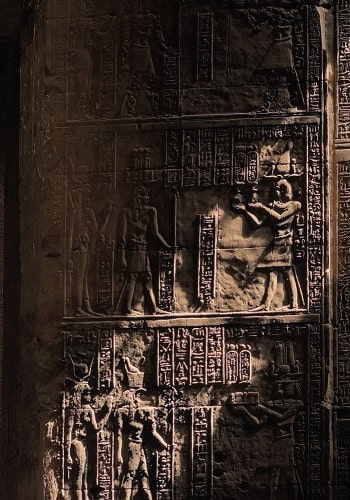Na Yuo Ni-Aebomē
On Ēhnuo island in Mēhayui, capital of Wīzoha Empire, Na Yuo Ni-Aebomē was built as the heart of Yuiwian faith, and a reminder of the unity between Sō and Nui, the two gods worshipped by its followers. A massive complex of buildings hidden between tall walls, it became the home of Yuiwian leadership as well as a place of worship.
Architecture
Temple Proper
The heart of Na Yuo Ni-Aebomē was the temple built on the island's highest point; layer upon layer of pale stone stacked on one another, each square-shaped floor more narrow than the one below, with open walking ways left at the outer edges of every layer. Most of the lower layers were modest in decoration, serving mainly as foundation for the veritable palace of gold and silver on top.
Half of the upper temple was painted in dark blue and silver, the other in rich green and gold—both sets being the colors and materials associated with Nui and Sō, respectively. The entrance—a tall, regal doorway into an open hall—was guarded by statues carved from the same stone as the building itself, with one representing a stalwart, shielded guardian of Sō, and the other a nimble glaive-wielding warrior of Nui.
Temple Gardens
Below the abode of gods grew a vast, fertile garden with fruit trees, herbs, flowers and a wide variety of berries and vegetables. The garden, designed as a pleasing environment as well as a useful source of food and herbs, was tended by gardeners—faithful followers vowed to Nui whose sole purpose was to the gardens they called home.
Pathways, all wide and well-maintained, snaked through the gardens. One main road connected the central temple with the rest of the island where the faithful of Yuiwia lived and studied. These humble abodes formed a small city by themselves, some of whom never knew the outside world.
Within the gardens lied a great pond, its artificial nature revealed only by its rectangular shape and sharp corners. Greenery filled its edges and both ducks and fish inhabited the blue water itself. Beneath the surface were also the young of water snakes—fabled children of Nui, born from her tears. Once too large for the pond, they were released into the waters of Lake Akao from which they found their way into the ocean.
On the opposite side of the garden laid a field of flame and ash, its size an exact copy of that of the pond dedicated to Nui. The field, made off of dark ash and bordered by large, rough-edged rocks, surrounded a great flame, the fire an eternal symbol of the power of Sō. Caretakers looked after the fire and stoked it through even the worst of storms.
Beneath Stars' Abode
Narrow hallways and small, dark rooms hid away beneath the shining palace at the top of the temple proper. There those sworn themselves to Sō and Nui worked in Halls of Record and the mysterious Niyimē, whose very existence remained unknown to most even within the complex itself.
History
Na Yuo Ni-Aebomē was built on Ēhnuo island, a piece of land given for the use by Sō-Thadi Soyaewa during his reign. What began as a small, humble abode for the faithful and a small temple for the celestial deities grew to become one of the greatest landmarks of Wīzoha Empire.
The complex, and the temple itself, was built as a symbol of unity between Sō and Nui, as well as their followers. While most of those who believed gave respects and sacrifices to both of the celestials, those who dedicated themselves to only one often found it difficult to work with the 'other side'.
What was intended as a place of peace became a site for one of the bloodiest events in the history of Wīzoha Empire. During Sētki a Nimē, a decade long civil war between the two halfs of Yuiwian faith, Na Yuo Ni-Aebomē became a contested place of flame and death, as both Nimē a Nui and Nimē a Sō fought over ownership of the entire island it was built on.
The temple survived the carnage of war, though rebuilding efforts took decades afterward, and the city around it never fully recovered. In the early centuries of the Empire, Na Yuo Ni-Aebomē competed with Thadi-Ahomē for a position as the home of royal court and government. After the civil war, however, Yuiwian faith gradually lost its place within the government and became something of an outsider within matters of state.



Comments